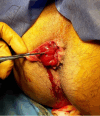What can patients expect in the long term from radiofrequency thermocoagulation of hemorrhoids on bleeding, prolapse, quality of life, and recurrence: "no pain, no gain" or "no pain but a gain"?
- PMID: 36217810
- PMCID: PMC11532375
- DOI: 10.3393/ac.2022.00311.0044
What can patients expect in the long term from radiofrequency thermocoagulation of hemorrhoids on bleeding, prolapse, quality of life, and recurrence: "no pain, no gain" or "no pain but a gain"?
Abstract
Purpose: The purpose of this study was to assess the long-term efficacy of hemorrhoidal radiofrequency thermocoagulation (RFT) on bleeding, prolapse, quality of life (QoL), and recurrence.
Methods: This retrospective, single-center study, with RFT performed using procedure modified via hemorrhoid exteriorization assessed the evolution of hemorrhoidal prolapse rated by Goligher scale; bleeding and discomfort (0-10), feeling of improvement and satisfaction (-5 to +5/5) by analog scales; the impact of hemorrhoids on QoL by HEMO-FISS-QoL score.
Results: From April 2016 to January 2021, 124 patients underwent surgery and 107 were interviewed in September 2021. The average follow-up was 30 months (range, 8-62 months). The mean work stoppage was 3 days, none in 71.0% of the cases. A mean of 4,334 J was applied. No analgesics were required for 66.4% of patients. External hemorrhoidal thrombosis was the only immediate complication in 9 patients, with no long-term reported complication. Bleeding disappeared in 53 out of 102 patients or dropped from 7 to 3 out of 10 (P<0.001). Prolapse reduced from mean grade 3 to 2 (P<0.001), discomfort from 7 to 2 out of 10 (P<0.001). HEMO-FISS-QoL score improved from 22 to 7 out of 100 (P<0.001). Feeling of improvement and overall satisfaction rate were +4/5. Recurrence occurred in 21.5% of patients at 22 months, and 6 required reoperation. Of the patients, 91.6% would choose the same procedure again and 96.3% recommend it.
Conclusion: RFT, although imperfect, leads to a significant improvement in hemorrhoidal symptoms and a lasting increase in QoL with minimal pain and downtime, high acceptance, and low complication and recurrence rates.
Keywords: Hemorrhoids; Minimally invasive surgical procedure; Quality of life; Radiofrequency ablation; Rafaelo procedure.
Conflict of interest statement
No potential conflict of interest relevant to this article was reported.
Figures



References
-
- Riss S, Weiser FA, Schwameis K, Riss T, Mittlböck M, Steiner G, et al. The prevalence of hemorrhoids in adults. Int J Colorectal Dis. 2012;27:215–20. - PubMed
-
- Nelson RL, Abcarian H, Davis FG, Persky V. Prevalence of benign anorectal disease in a randomly selected population. Dis Colon Rectum. 1995;38:341–4. - PubMed
-
- Sheikh P, Régnier C, Goron F, Salmat G. The prevalence, characteristics and treatment of hemorrhoidal disease: results of an international web-based survey. J Comp Eff Res. 2020;9:1219–32. - PubMed
LinkOut - more resources
Full Text Sources
Research Materials
Miscellaneous

